The Death Of Subculture part 3: The role of poverty and social class
This is the third article in a series that aims to explore how subculture has changed in the last 30 years. Click here to read part one or here for part two.
The role of poverty
As Noah Harari explains in both Sapiens and Homo Deus, for hundreds of years, poverty, income and social status were proportionate and/or linked. This really began to change in the UK in the 1700s as a merchant class emerged (though the peasants who survived the Black Death were able to command higher wages and the social order began to shift). Emerging ideas of social justice, liberalism and the rights of the individual also went some way to setting up institutions and laws to help the underprivileged in society. Imperialism, colonialism and globalisation brought vast amounts of money into the UK, and more than ever before filtered down the social structure. Since then, continued Western affluence, education and increased social mobility has continued to affect the UK’s social structure, with increasing amounts of money flowing more freely between classes than ever before. This continued after World War II – notably with the creation of the NHS.
While great leaps were made in the 200 years from 1750 to 1950, absolute poverty levels were still very high for many British people. Wholesale changes in attitude and legislation have continued to reduce absolute poverty levels since the 1950s.
Commentators say that this decline in poverty and the decline of British manufacturing/mining/manual farming, has resulted in the shrinking of the traditional British working class – the source of many subcultures.
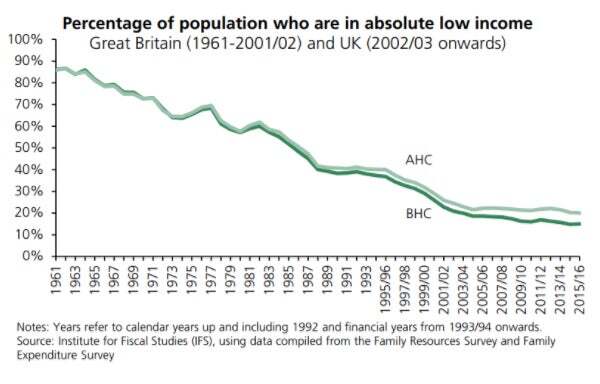
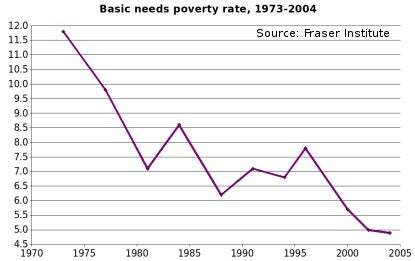
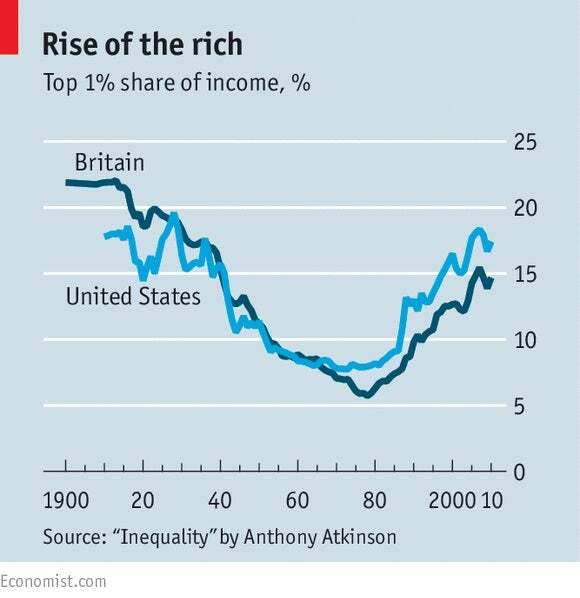
It is worth noting that while fewer people live in poverty, more people are becoming super rich – widening the equality gap.
The role of social class
Subcultures usually emerged organically, and usually emerged from disenfranchised or marginalised groups:
- Punks – young white working class at a time of the highest unemployment since 1940 – post Wall St Crash.
- Hip hop/b-boy culture – young urban black youth in 1970s New York who were discriminated against.
- Hippies – post-War teens who didn’t share their their parents’ drives, values or aspirations.
- Ravers/new age travellers/free party scene – people reacting to the draconian rule and materialism of Thatcher’s Britain.
Has Western affluence drawn the well of ‘teenage angst’ dry? The traditional British working class have been ‘upgraded’ to middle class living with access to travel, food, goods and the lifestyles of the privileged (though some say it is the middle classes who have disappeared…). Has more comfortable living led to fewer expressions of oppression?
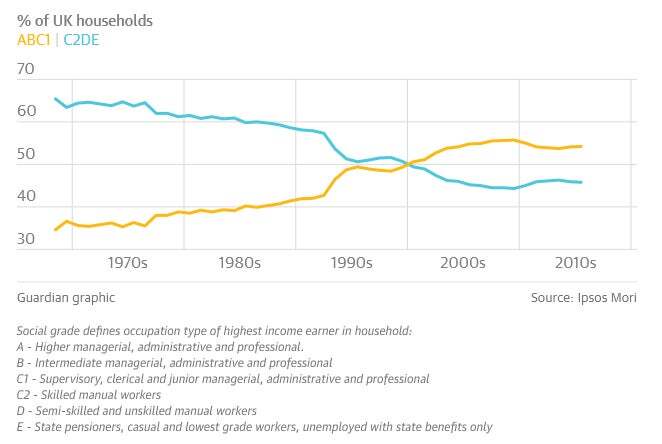
Graphic from the Guardian. ABC1 (described in the caption below) and C2DE (Skilled manual occupations and semi-skilled & unskilled manual occupations, Unemployed and lowest grade occupations).
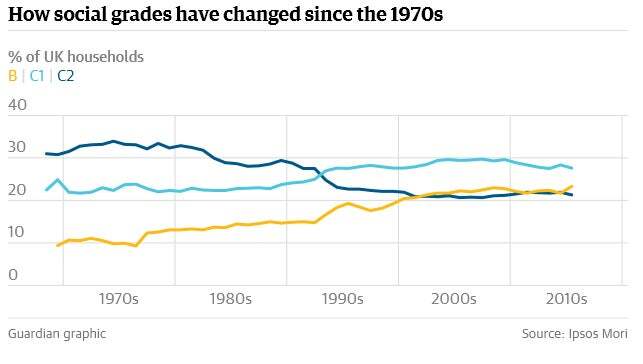
Graphic from the Guardian. Social status based on profession as used by the UK Office For National Statistics: B = Higher & intermediate managerial, administrative, professional occupations, C1 = Supervisory, clerical & junior managerial, administrative, professional occupations and C2 = Skilled manual occupations
The relationship between the middle and working class is often complex when it comes to subculture. While most subcultures are driven by working class ‘needs’, it is often individuals or small groups from the middle class who create/organise/drive the actual movement – their privilege (money, connections, education, cultural capital) often facilitating this. These progenitors would ‘recruit’ the first wave of working class protagonists, who give the movement credibility while the middle class creators fade into the background, aware their presence undermines the credibility of the movement (there are numerous examples of upper/middle class people trying to conceal their backgrounds for this reason). At a critical point, other members of the middle class join the subculture – attracted by its working class authenticity and credibility.
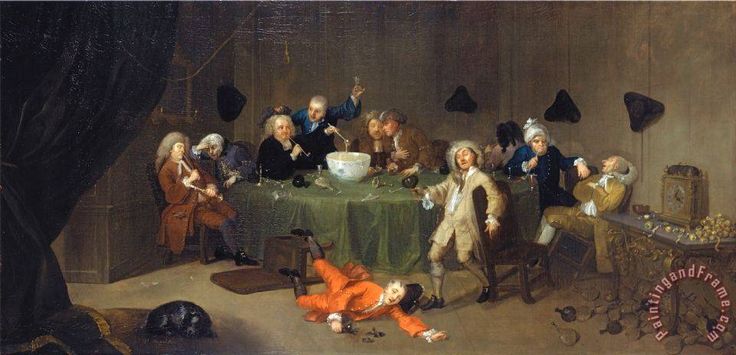
Many of William Hogarth’s paintings reflect the change of British society in the early 1700s as he wove social commentary into his work.
This is a mainly 20th century phenomenon. Ideas of social justice progressed to a place where the upper/middle classes wanted and were able to fight for the rights of the under-privileged. From the government on down, people wanted to help those beneath them and so many in the middle classes (the liberal and progressive elites) supported working class causes – socially, politically and subculturally. This is of course a generalisation and exceptions exist but too many examples support the claim – from rave and punk to acid culture and the beat generation.
So the underrepresented, the discriminated against and the disenfranchised are the most likely to form subcultures. This may explain the disproportionate number of subcultures to emerge from ethnic minority communities in the West in the last 50 years – people who are often in the lower social strata and subject to societal and institutionalised discrimination. There are many examples, from hip-hop and techno to jungle, garage and grime. Music is the perfect (and sometimes the only) mouthpiece for people who have no social, political or community representation.
Today, Western society is often accused of being apathetic – especially politically – but this is simply a byproduct of being ‘happy’. With fewer people having anti-establishment statements to make, no statements are being made, and the tools of subculture become redundant.
We are witnessingthe rise of musical forms and fashion trends without a sociopolitical message
While expressing societal frustration through subculture may have waned, the innate emotional needs of belonging and feeling valid, still exist. These needs can be sated without subculture. For exmaple:
- Need for an identity – traditionally may have joined a group to adopt the group identity – but now individual identities are easy to create and are valid.
- Need to ‘have a voice’- traditionally may have joined a subculture/demonstrated – but now have social media, blogging, pressure groups, political representation and other legitimate avenues.
The tools of subculture – music, clothing – are now serving individuality. This claim could be supported by the dominance of musical forms and fashion trends without a sociopolitical message – and in particular musical experimentation for its own sake.
Some say that government cuts to arts funding mean those of restricted economic means are unable to participate in the art, theatre or music worlds.
Music supervisor Ross Gidney agrees: “These days, people from working class backgrounds are far less likely to be able to get their message heard than once before. Development deals at record labels, enabled bands to find their feet. it wasn’t uncommon for a band to make no money until their third, sometimes longer. However, they got good at what they did and over time had financially successful careers. This doesn’t happen any more. And it’s not just music, it’s true if all art forms in the UK. What we see are those from privileged backgrounds, with the funding in place for them to survive the years in the wilderness, eventually becoming the leading artists in their field, with the mass exposure.”
Others counter this argument, saying that the best art, the most innovative and most important art often comes from the disenfranchised and money rarely restricts the expression.
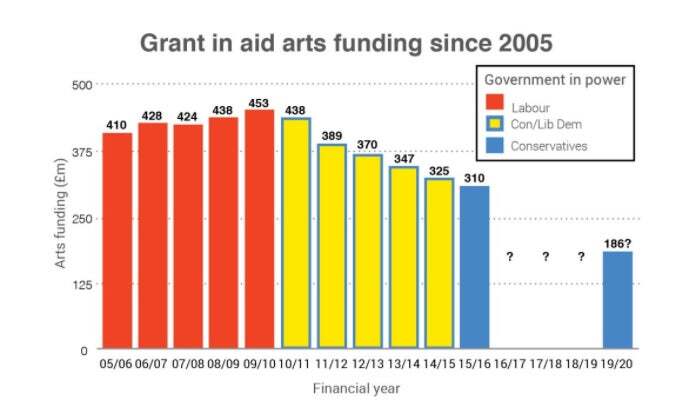
Does this graph correlate with a decline in subculture or ‘great art’?
Soma
Characters in Aldous Huxley’s Brave New World take a drug called ‘soma’, which gives individuals a feeling of happiness and contentedness. This ultimately serves those in power as the masses are less likely to revolt if they’re happy. That which is seen as great for people, is in fact most beneficial for those in power.
I would not be the first to suggest that consumerism, mass media and social media is performing this role in Western society today.
The devil makes work for idle hands. And those dissenters who may have caused unrest in a past era are now playing X Box, vlogging or buying disposable t-shirts in Primark. In another time, would these people have started an important youth movement? With disposable incomes and the internet, no teenager’s hands need never be idle.
…people of all classes have more choice, which will fundamentally lead to less subculture
‘Art school’
Read enough biographies of musicians and bands and you start to see patterns. Working class subcultures were often a literal escape from poverty or oppression, but for many middle-class players, involvement is an ethical, intellectual or ideological exercise. (I’m aware that this is a generalisation, and exceptions are many, but the pattern still exists).
As such, the music of the disadvantaged often carried that message (hip-hop, funk, punk, US garage/house, grime) because that was its raison d’etre. The music of privilege rarely addresses these issues. Look at the lyrical output of Radiohead and Muse vs Dizzee Rascal and The Streets. Notable exceptions include public school punk Joe Strummer and the anti-yuppy indie of Blur and the output of East End heavy metal pioneers Iron Maiden – whose lyrics referenced such esoterica as Frank Herbert science fiction and Samuel Coleridge.
Great reads
- Underclass heroes
- Miles, the autobiography – Mile Davis with Quincy Troupe
- Dear Boy: The Life Of Keith Moon – Tony Fletcher
- Beneath The Underdog – Charles Mingus
- Jack Kerouac: King Of The Beats – Barry Miles
- White Line Fever: Lemmy: The Biography – Lemmy Kilmister
- Pimp: The Story Of My Life – Iceberg slim
- The intellectual set
- William S Burroughs: A Life – Barry Miles
- The Shameful Life of Salvador Dali – Ian Gibson
- Redemption Song: The Definitive Biography Of Joe Strummer – Chris Salewicz
- No One Here Gets Out Alive: the biography of Jim Morrison – Jerry Hopkins

Insider view
Studies say that most subcultures have working class/underclass origins (skinheads, heavy metal, punk, jungle; jazz, blues, techno, hip hop). Some say that Western affluence (and the disappearance of the traditional British working class) is the reason for a decline in subculture.
Our panellists have very different views on this issue…
[NB: head to the first article to read more about who our panellists are]
“That’s bollocks. I’m originally from the ‘Socialist Republic of South Yorkshire’ and I can tell you that the county is as working class now as it ever was. If there is a decline [in musical subcultures], I think it’s due to the fact that they no longer stand at the vanguard of communication. There are now so many avenues of expression that music is now among the pack, rather than its leader.
“Grime is probably the last big subculture. It represents the voice of inner London from people whose existence was being squeezed and marginalised. This can be heard in its defiance and its validity is reinforced by its capacity to frighten.”
Ian Winwood

Grime artists: JME, Lethal Bizzle, Bugzy Malone, Skepta and Stormzy
“When I was growing up [1980s/90s], to be working class seemed different to now. Access to what people have has changed: mobile phones, the internet, TV on-demand. It’s all accessible. It allows people of all classes to have more choice, which will fundamentally lead to less subculture.”
Jon Luis Jones
“The working class isn’t disappearing and the ‘chav’ (hate the word, but you know what I mean) lifestyle is probably the biggest working class sub cult. It’s a continuation of mod in that it fetishises brands, cutting edge black music – hip hop (for boys) and R&B (for girls) – and is associated with moral panics.
“There are fewer teenagers around than there were 30 years ago, that may be a factor.”
Tommy Udo
“The underclass that would have traditionally made up these subcultures probably can’t afford to spend time or money on forming bands, writing scripts/zines or learning performance skills. The working class isn’t gone. It’s just been priced out. And they always created the best art.
“In Stewart Lee’s book he talks about how he was earning £30 a week from doing gigs in London in the 1980s and that was enough for him to pay his rent. The idea that you could dedicate your time to those skills today, is absurd. You’d have to have a full-time, well-paid job, just to be able to survive in a city like London.

Stewart Lee telling an audience: “Twitter is the Stasi for the Angry Birds generation”
“If you want to break into the arts but aren’t part of an upper middle-class elite then those avenues are closed to you. I’m sure there are thousands of brilliantly creative people all over the country that aren’t able to develop their skills purely because financial responsibilities take up all of their time.
Steve Hill
“Sounds like bollocks to me. There’s still a lot of poor, angry people out there.”
Scott Rowley
“Being working class alone isn’t validating. You can be wealthy and still feel the blues or have soul or truly ‘get it‘.”
Ali Divers
“Most of these subcultures are underpinned by music which is ultimately art. Art and music (real music) are born from a reaction or dissatisfaction with life. This often stems from not having it so easy. Most Western culture comes from money these days and is born from marketing, so I’d agree this might be a reason for its decline.”
Joel Priestland
Most Western culture comes from money these days and is born from marketing
“Great creative ideas often start with an enemy: a big problem that creativity can help overcome. The hippies were trying to overcome the threat of nuclear destruction with the peace movement.
“Today, there may be less of a clearly defined enemy to rub up against and create a focused friction point that subcultures thrive on.
“I think the next subculture might be a rebellion against a common enemy we are controlled by everyday: a corporation or even a technology that we are shackled to – a subculture could spring from that. It’s hard to predict, but I think it could come from ideas of disconnection or ‘going off grid’.”
Russ Tucker
“While I agree to a certain extent, the homogenisation of culture is still behind it. The working classes do still exist. I grew up through it and my home town is still very much working class.”
Julie Weir

This is a collection of pieces I saw in one short walk in London: anti-consumerism, ant-establishment, animal rights, anti-Trump. You have no platform for your views. How do you make your message heard? Graffiti. Political graffiti is one expression of those who feel they have no voice. We used to ‘write on someone’s wall’ on Facebook. The web has replaced tangible walls and its messages of dissent – aiming it to those who already think it.
“Most subcultures have working-class origins, and art and subcultures were usually born out of struggle or oppression. However, I also believe the working class is still very prevalent in the UK. Not so much in richer areas in the south of the country, but it certainly survives elsewhere.”
“Also, the many middle-class individuals who came from working-class parents, are surely feeling disenfranchised and still have a message they would like to get out there and that is worth telling.
“The problem lies with the fact that people from these backgrounds are far less likely to be able to get their message heard than once before. Development deals at record labels enabled bands to find their feet. It wasn’t uncommon for a band to make no money until their third, sometimes longer. However, they got good at what they did and over time had financially successful careers. This doesn’t happen anymore. And it’s not just music, it’s true if all art forms in the UK.

Middle-class music: drum and bass due Fred V & Grafix, Brighton-based metal band Architects, Frank Turner, Clean Bandit.
“What we see are those from privileged backgrounds, with the funding in place for them to survive the years in the wilderness, eventually becoming the leading artists in their field, with the mass exposure.”
Ross Gidney
“This strikes me as bollocks. Generally, the people who keep claiming that the British working class has disappeared are the British middle class. They just tend not to go to British working class areas ie classes have become more segregated.
“Is Western affluence to blame for the decline of youth subculture? In a way, yes, but not as this study claims. Conversely, it’s because the poor have got poorer and are too busy being concerned where their next pint of milk and loaf of bread is coming from to be thinking about if they have the right shirt or latest hip-and-happening sounds.
“Being part of a subculture is as much a sense of belonging to a tribe than the style of the subculture itself. In areas like London and Manchester, that sense of belonging is catered for by gang culture. The US style of territorial/postcode gangs is now rife in those cities. Ironically it’s a throwback to the 1950s subculture of Teds or Mods and rockers, who had rivalries and fights about territory as much as their subculture itself.”
Alex Burrows
“This is entirely correct… Well, that and a succession of conservative-leaning governments steadily subjugating youth into slavery.”
Ian Fortnam
Nandos and nice trips to the cinema do not John Lydon make…
“I think the loose definitions of working class and middle class have changed so much in recent years that it must have played a part. Those who might have been considered working class 25 years ago probably have more important things on their mind than what subculture they’re in – nearest food banks etc.
“Those considered middle class now – on the housing ladder, ok income – probably don’t feel the need to align themselves with a subculture as most things are available to them online.
“While it’s easier for a kid to make music in their bedroom, the working class kids probably don’t have access to a laptop and a decent amount of software to play with. The middle-class kids probably don’t have the drive to ‘drag themselves out of the gutter’. Nandos and nice trips to the cinema do not John Lydon make…”
Scott Bartlett
“I have mixed views on this. You can argue that amongst the poorer, more impoverished youth, those without a voice, the desire to be part of a movement – any movement – will be greater. The weak come together to tackle the strong. Anyone who feels like an outsider will seek others who feel the same way, but it doesn’t explain everything.
“Punk was a middle-class movement started on The King’s Road in Chelsea by toffs like Mclaren and Westwood. Only with the later more aggressive punk and Oi! bands did it start to be adopted by working-class kids.
“Most heavy metal fans I knew were nice middle-class kids who rebelled against their bourgeois parents by listening to noisy music and dressing like bikers.
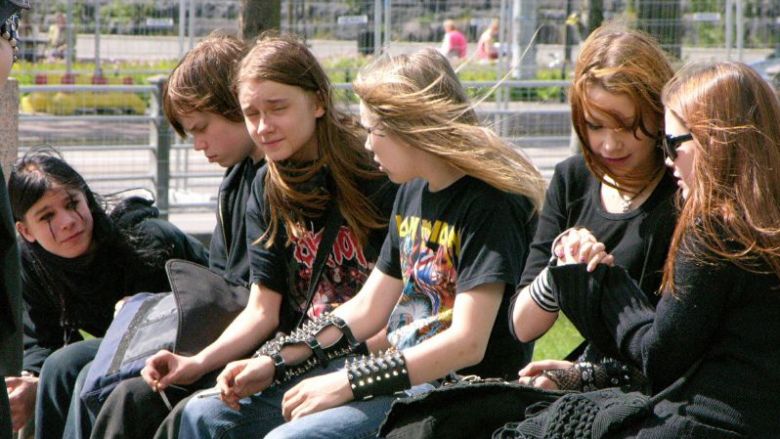
“The Mod movement was generally working class because it was aspirational. A load of kids from council estates wearing designer clothes and riding scooters as if they were in Verona in the 1950s.
“Jazz, Blues and Hip Hop were all born out of the struggles of black people


